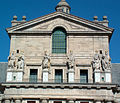Juan de Herrera
Juan de Herrera | |
|---|---|
Valladolid Cathedral |
Juan de Herrera (1530 – 15 January 1597) was a Spanish
geometrician
.
One of the most outstanding Spanish architects in the 16th century, Herrera represents the peak of the
Herrerian style was named after him, and was representative of the architecture of the Spanish Empire of Philip II
and his Austrian successors.
Herrera was interested in many branches of knowledge. His Discurso sobre la figura cúbica (Discussion of the Cubic form) tells us about his notable knowledge about geometry and mathematics. He participated in the military campaigns of Charles V in Germany, Flanders and Italy.
Biography
Juan de Herrera started his architectural career in 1561 with the
Royal Palace of Aranjuez
. In 1562 he also made some drawings for the Libro del saber de astronomía (The Book of Astronomical Knowledge).
In 1563 he started to work under
Herrerian
style.
The
Plaza Mayor in Madrid
.
As instructed in his 1584 will, after his death, his sepulchre was transferred from Madrid to the Church of San Juan Bautista in Maliaño, Cantabria.[1]
Main works
Segovia Bridge
, in Madrid.- Palacio Real de Aranjuez(1561)
- El Escorial (1563)
- Palace of El Quexigal (1563), building since disappeared, built in Robledo de Chavela (Madrid)
- South Façade of the Alcázar de Toledo(1571–1585)
- Casa Consistorial de Toledo (1575)
- Puente de Segovia in Madrid(1582–1584)
- Design of the Lonja de Archivo de Indias(1583)
- Valladolid Cathedral (1589)
- Real Aposento de Torrelodones (1589), building since disappeared, built in Torrelodones.
- Puerta de Triana (1588) (demolished). One of the gates of the Walls of Seville.
Gallery
-
El Escorial, by Juan Bautista de Toledo and Juan de Herrera.
-
Façade of the Monastery of El Escorial
-
Detail of the Court of the Kings, in El Escorial.
-
Dome of the Basilica of El Escorial
-
Houses in front of the Monastery of El Escorial.
-
Archivo de Indias, Seville
-
Valladolid Cathedral
-
Model of the project of Herrera for the Cathedral of Valladolid.
-
Royal Palace of Aranjuez
See also
- Catedral de Valladolid
- Monasterio de El Escorial
- Palacio Real de Aranjuez
- Valdáliga
- Camargo, Cantabria
References
- ^ Ceán Bermúdez, Juan Agustín (1800). Diccionario histórico de los más ilustres profesores de la Bellas Artes en España. Vol. IV. Madrid. pp. 87–93. Archived from the original on 2016-03-09. Retrieved 2020-08-14.
External links
Wikimedia Commons has media related to Juan de Herrera.









